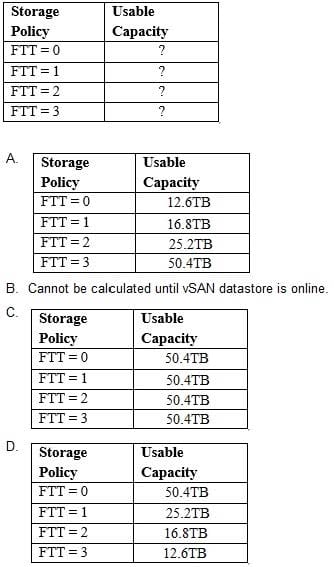Exam Details
Exam Code
:2VB-601Exam Name
:VMware Specialist: vSAN 6.xCertification
:VMware CertificationsVendor
:VMwareTotal Questions
:109 Q&AsLast Updated
:Dec 22, 2024
VMware VMware Certifications 2VB-601 Questions & Answers
-
Question 31:
The following are configuration details for a three-node vSAN cluster:
1.
Each host has two disk groups and each disk group has 7x1.2TB 10K SAS drives.
2.
Each host has 16.8TB of raw capacity and the three-node cluster has 50.4TB of raw capacity.
3.
Deduplication and compression are not enabled.
Based on the following FTT Values in the storage policy, what is the total usable capacity?

A. Option A
B. Option B
C. Option C
D. Option D
-
Question 32:
The following are configuration details for a 10-node hybrid vSAN cluster:
Each node has 7 x 2 TB magnetic disks, 1 x 800 GB SSD.
What is the raw capacity of this cluster as configured?
A. 148TB
B. Not enough information provided. Cannot be calculated.
C. 140TB
D. Cannot be calculated until vSAN is online.
-
Question 33:
vSAN supports Microsoft Windows Server Failover Cluster (WSFC) with which configuration?
A. File share witness quorum with Exchange Database Availability Groups, SQL Server AlwaysON Availability Groups (AAG)
B. Virtual raw device mapping (RDM) with Exchange Database Availability Groups, SQL Server AlwaysOn Availability Groups (AAG)
C. FCI witness quorum with Exchange Database Availability Groups, SQL Server AlwaysOn Availability Groups (AAG)
D. NFS mount witness quorum with Exchange Database Availability Groups, SQL Server AlwaysON Availability Groups (AAG)
-
Question 34:
What is the Storage-Based Management framework primarily used for?
A. Providing a single unified control plane across a broad range of data services and storage solutions
B. Defining target deduplication and compression ratios and distributing workloads to optimize space efficiency based on the defined targets
C. Ensuring an appropriate RPO is assigned and monitored using either synchronous or asynchronous replication of a datastore
D. Reducing the latency on datastores by distributing IO across physical devices by abstraction and pooling of resources
-
Question 35:
Which three of the listed categories appear in the vSAN Health user interface? (Choose three.)
A. Network
B. Physical Disk
C. Device Mapping
D. Hardware Compatibility
E. Replication
-
Question 36:
When using RAID-5 with a 100GB virtual disk, what is the maximum capacity consumed on the vSAN datastore for this virtual disk?
A. 100GB
B. 150GB
C. 133GB
D. 200GB
-
Question 37:
An eight-node vSAN cluster has been deployed. vSAN fault domains are NOT configured. A virtual machine with a 100GB virtual disk (VMDK) is created on the cluster. The 100GB virtual disk is assigned a storage policy with the following rules:
1.
Primary level of failures to tolerate = 1
2.
Failure tolerance method = RAID-1 (Mirroring) ?Performance
Which statement is true about how vSAN places the component(s) that make up this object?
A. Three mirrored data components are created and distributed across separate hosts. There is NO need for a witness component.
B. Three mirrored data components plus a witness component are created. The data components are distributed across three hosts in the cluster. Witness components are placed on the hosts that contain data components to verify the data components are online.
C. One data component is created to minimize capacity consumption. Two witness components are placed on separate hosts to avoid "split-brain" scenarios.
D. Two mirrored data components plus a witness component are created. The components are distributed across three nodes in the cluster.
-
Question 38:
Which two VM Storage Policy rules are supported with vSAN iSCSI Target LUNs? (Choose two.)
A. Replication
B. RAID-5/6 erasure coding - Capacity
C. Deduplication and Compression
D. Force Provisioning
-
Question 39:
Which statement is true about the deduplication and compression feature in vSAN?
A. Redundant blocks across multiple disk groups are NOT deduplicated.
B. Compression removes redundant data blocks, whereas deduplication removes additional redundant data within each data block.
C. Compression occurs as data is moved from the capacity tier to the cache tier.
D. Deduplication and compression are enabled by default when the vSAN cluster is created.
-
Question 40:
What is the purpose of the cache tier in an all-flash vSAN cluster?
A. Read caching only.
B. 30% write caching and 70% read caching.
C. 20% write caching and 70% read caching and 10% checksum metadata.
D. Write caching only.
Related Exams:
1V0-21.20
Associate VMware Data Center Virtualization1V0-31.21
Associate VMware Cloud Management and Automation1V0-41.20
Associate VMware Network Virtualization1V0-61.21
Associate VMware Digital Workspace1V0-71.21
Associate VMware Application Modernization1V0-81.20
Associate VMware Security2V0-11.24
VMware Cloud Foundation 5.2 Administrator2V0-11.25
VMware Cloud Foundation 5.2 Administrator2V0-13.24
VMware Cloud Foundation 5.2 Architect2V0-21.20
Professional VMware vSphere 7.x
Tips on How to Prepare for the Exams
Nowadays, the certification exams become more and more important and required by more and more enterprises when applying for a job. But how to prepare for the exam effectively? How to prepare for the exam in a short time with less efforts? How to get a ideal result and how to find the most reliable resources? Here on Vcedump.com, you will find all the answers. Vcedump.com provide not only VMware exam questions, answers and explanations but also complete assistance on your exam preparation and certification application. If you are confused on your 2VB-601 exam preparations and VMware certification application, do not hesitate to visit our Vcedump.com to find your solutions here.